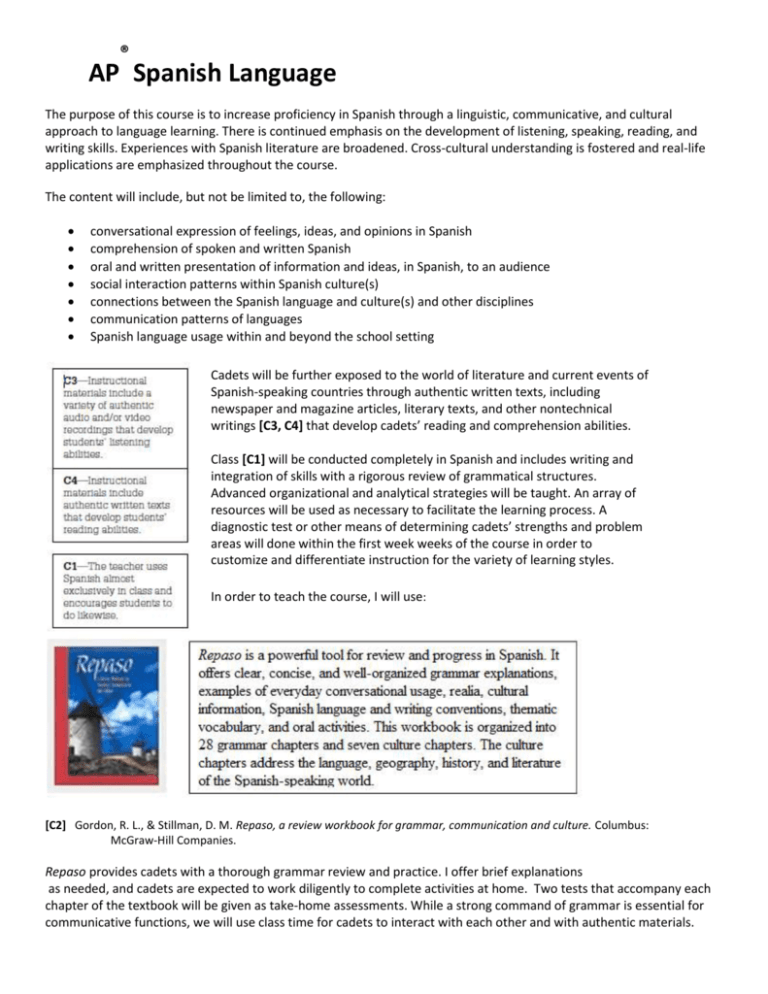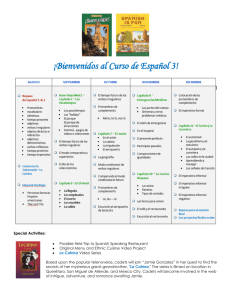
®
AP Spanish Language
The purpose of this course is to increase proficiency in Spanish through a linguistic, communicative, and cultural
approach to language learning. There is continued emphasis on the development of listening, speaking, reading, and
writing skills. Experiences with Spanish literature are broadened. Cross-cultural understanding is fostered and real-life
applications are emphasized throughout the course.
The content will include, but not be limited to, the following:
conversational expression of feelings, ideas, and opinions in Spanish
comprehension of spoken and written Spanish
oral and written presentation of information and ideas, in Spanish, to an audience
social interaction patterns within Spanish culture(s)
connections between the Spanish language and culture(s) and other disciplines
communication patterns of languages
Spanish language usage within and beyond the school setting
Cadets will be further exposed to the world of literature and current events of
Spanish-speaking countries through authentic written texts, including
newspaper and magazine articles, literary texts, and other nontechnical
writings [C3, C4] that develop cadets’ reading and comprehension abilities.
Class [C1] will be conducted completely in Spanish and includes writing and
integration of skills with a rigorous review of grammatical structures.
Advanced organizational and analytical strategies will be taught. An array of
resources will be used as necessary to facilitate the learning process. A
diagnostic test or other means of determining cadets’ strengths and problem
areas will done within the first week weeks of the course in order to
customize and differentiate instruction for the variety of learning styles.
In order to teach the course, I will use:
[C2] Gordon, R. L., & Stillman, D. M. Repaso, a review workbook for grammar, communication and culture. Columbus:
McGraw-Hill Companies.
Repaso provides cadets with a thorough grammar review and practice. I offer brief explanations
as needed, and cadets are expected to work diligently to complete activities at home. Two tests that accompany each
chapter of the textbook will be given as take-home assessments. While a strong command of grammar is essential for
communicative functions, we will use class time for cadets to interact with each other and with authentic materials.
[C2, C4, C6, C7]
Barlow, G. Leyendas latinoamericanas. Columbus, Ohio: McGraw-Hill Companies.
Barlow, G., & Stivers, W. Leyendas de españa. Columbus, Ohio: McGraw-Hill Companies.
Gonzalez, O. Leyendas cubanas. Columbus, Ohio: McGraw-Hill Companies.
Muckley, R. L., & Martinez-Santiago, A. Leyendas de puerto rico. Columbus: McGraw-Hill Companies.
This telenovela is designed to support language acquisition and vocabulary
development.” We will be watching one of the 20-minute episodes and
discussing the storyline. After which time cadets will follow-up with
activities specifically designed by me to provide authentic use of language
by supporting correct usage of grammar, spelling and style. Additionally,
this telenovela allows cadets to “visit” locations and have experiences that
would not be available to them otherwise. [C3, C4, C5, C7]
[C1, C3, C5] Curland, D. (1999). La Catrina, el ultimo secreto. Glenview, Illinois: Addison-Wesley Educational Publishers, Inc
This text enables cadets to enhance proficiency in Spanish
through a linguistic, communicative, and cultural approach to
language learning. There is continued emphasis on the
development of listening, speaking, reading, and writing skills
and on acquisition of the fundamentals of applied grammar;
while fostering cross-cultural understanding and real-life
applications via the accompanying videos and audio CDs.
[C1, C2, C3, C4, C5, C7] Schmidt, W. (2007). Buen Viaje, Glencoe Spanish 3. Columbus: Glencoe McGraw-Hill
Each unit focuses on language skills and testing formats used in the
Advanced Placement Examination. Cadets become familiarized with
the actual directions together with the different types of exercises as
they appear on the test. Cadets gain confidence with the sufficient
practice provided therein together with the accompanying audio
tracks. [C6, C7]
[C1, C2, C3, C4, C5, C6, C7] Diaz, J. M., Leicher-Prieto, M., & Nisseberg, G. (2007). AP* Spanish preparing for the language
examination. Boston, Massachussetts: Pearson Prentice Hall.
Teaching Strategies
As we are a Military Academy, Cadets begin each day called to attention. Attendance is taken followed by one
cadet called to the front of the class in order to lead them in reciting the Pledge of Allegiance to the Flag, The
School Code of Honor and the Preamble to the Constitution of the United States – all in Spanish.[C1]
Then, the class is ready to begin. Each lesson will presented, followed by a written assignment or class
discussion – all in Spanish. Occasionally, we watch ¡Despierta America!, on Galavisión (live television
broadcast), as our primary authentic source [C3]; followed by a discussion of some of the latest news, fashion,
or sports news covered during the telecast to ensure comprehension and promote fluidity. Additionally,
readings from the Leyendas series or an Episode from La Catrina, on video, will be introduced to enrich further
the learning experience. In conjunction with teacher-taught lessons, video/audio recordings, periodicals,
texts and written assignments [C4], all lessons are enhanced by a multimedia approach to account for
differentiation of instruction, thereby creating a least restrictive environment for learning and communication.
(Barlow & Stivers, Leyendas de españa) (Curland, 1999) (Mohamed, 2009) (Ponteiro, 2010) (Schmidt, 2007)
(Wong, 2007) (Gordon & Stillman) (Diaz, Leicher-Prieto, & Nisseberg, 2007)
The Academy is on the block schedule – four 80-minute periods per day with a 40-minute lunch break. The
situation is ideal because it allows cadets to complete their foreign language college requirement in one
academic year – level one in the fall and level two in the spring – and so on.
The Foreign Language Program at the Academy targets college bound cadets inasmuch as foreign language
credits are not required for graduation. My challenge is meeting the varying needs of cadets while fulfilling
the demands of the content. (Spinelli, 2003) (Theisen & Loveland, 2010)
Student Evaluation
Exams generally include matching or multiple-choice sections, fill-in the-blank sections, and short
answer or essay sections.
Final Project will include group presentations, research, use of technology and class discussions [C2]
Instruction in writing is evidenced by instruction in brainstorming, pre-writing, writing an
introduction/conclusion, providing details and synthesis. Most compositions are modeled on the
format used in the AP Exam. However, some creative writing compositions are assigned as well. [C6]
Cadets will be required to keep a Journal – cadets will be asked to write approximately 10 pages in
their journal throughout the semester. This includes AP-style essays and free-choice pages.
Additionally, they will be required to include one additional page for each day they are absent from
class. [C6]
Collaborative project participation [C4, C5, C7] – cadets will work within groups, as members of the
entire class, to write, perform in, video tape and produce a 15-minute, original syntactically-correct skit
based on one of the myriad of themes covered throughout their previous semesters of Spanish.
Cadets grade their own participation and each other’s using a rubric.
The final includes portions of previous AP Exams, reshaped to model the exam item types as identified
in the AP Spanish Course Description [C2].
AP Unit Calendar
JANUARY
Repaso de los
verbos
-El presente
-El futuro
-El condicional
-El pretérito
-El imperfecto
-Modos perfectos
-Los verbos
FEBRUARY
MARCH
Repaso de la
gramática
-artículos
-plurales
-reconciliando
-pronombres
Repaso de la
gramática
-posesivos
-demostrativos
-adverbios
-preposiciones
Aprender el
subjuntivo
Texto Repaso
-Modismos
La Catrina – el
ultimo secreto
Escuchar
diálogos y
narrativas
Repaso de la
gramática
-pronombres
relativos
-por, para
-la voz pasiva
MAY
Repaso de la
gramática
Escuchar
diálogos y
narrativas
-comparaciones
car, gar zar
Repaso de la
gramática
-ir + a
-hace…que
-tener que
-acabar de
APRIL
Buen Viaje 3
-la geografía
-la historia de
España
Texto Repaso
-Modismos
Lecturas en la
serie Leyendas
de España
La Catrina – el
ultimo secreto
Diarios
Memorizar y
recitar el
Preámbulo de
la Constitución
Practicar para
el Examen AP
-escuchar
-hablar
Vocabulario
nuevo
Ver Despierta
América y
participar en
Practicar para
el Examen AP
-escuchar
Vocabulario
nuevo
Ver Despierta
América y
participar en
discursos orales
Lecturas en la
serie Leyendas
de Puerto Rico
-superlativos
Laboratorio
Texto Repaso
-Modismos
Vocabulario
nuevo
Escuchar
diálogos y
narrativas
Ver Despierta
América y
participar en
discursos
Vocabulario
nuevo
Ver Despierta
América y
participar en
Lectura en la
serie Leyendas
de España
Diarios
discursos orales
Lecturs en la
serie Leyendas
Diarios
Latinoamericanas
Diarios
discursos orales
Practicar para
el Examen AP
-escuchar
-hablar
-escribir
Vocabulario
nuevo
La Catrina – el
ultimo secreto
Comenzar los
Diarios
Laboratorio
Laboratorio
Laboratorio
Presentar el
proyecto final
Practicar para
el Examen AP
-escuchar
-hablar
-escribir
-leer
La Catrina – el
ultimo secreto
Laboratorio
Tomar el
Examen AP
La Catrina – el
ultimo secreto
Proyectos
finales
Examen Final
Resources
Barlow, G. Leyendas latinoamericanas. Columbus, Ohio: McGraw-Hill Companies.
Barlow, G., & Stivers, W. Leyendas de españa. Columbus, Ohio: McGraw-Hill Companies.
Curland, D. (1999). La Catrina, el ultimo secreto. Glenview, Illinois: Addison-Wesley
Educational Publishers, Inc.
Diaz, J. M., Leicher-Prieto, M., & Nisseberg, G. (2007). AP* Spanish preparing for the
language examination. Boston, Massachussetts: Pearson Prentice Hall.
Gonzalez, O. Leyendas cubanas. Columbus, Ohio: McGraw-Hill Companies
Gordon, R. L., & Stillman, D. M. Repaso, a review workbook for grammar, communication
and culture. Columbus: McGraw-Hill Companies.
Mohamed, E. (2009). Integrating Technology In The Classroom. Retrieved October 18,
2010, from Mohamed Esa: www2.mcdaniel.edu/.../IntegratingTechnologyEsa2009
Muckley, R. L., & Martinez-Santiago, A. Leyendas de puerto rico. Columbus: McGraw-Hill
Companies.
Ponteiro, P. B. (2010, September 1). Integrating Technology in the Second Language
Classroom. Retrieved October 18, 2010, from SUNY Courtland:
http://www.cortland.edu/flteach/mm-course/mm-syl.html
Schmidt, W. (2007). Buen Viaje, Glencoe Spanish 3. Columbus: Glencoe McGraw-Hill.
Spinelli, E. (2003). English grammar for students of Spanish. Dearborn, Michigan: Olivia
and Hill Press.
Stroud, P. M. (1998, September 14). Incorporating technology into the foreign language
classroom. Retrieved October 18, 2010, from Technology In The Foreign
Language Classroom: www.trinity.edu/mstroud/technology/CALL.html
Sutherland, A. (Copyright © 2005-2010). Quizlet LLC. Retrieved October 18, 2010, from
http://quizlet.com/subject/spanish-buen-viaje-spanish
Theisen, T., & Loveland, C. (2010). Differentiated instruction in the foreign language
classroom: meeting the diverse needs of all learners. Austin: Languages
Other Other Than English Center for Educator Development.
Wong, K. (2007, November 15). Use of smartboard technology in the foreign language
classroom. Retrieved October 18, 2010, from press.georgetown.edu:
http://www.allacademic.com/meta/p173954 index.html






